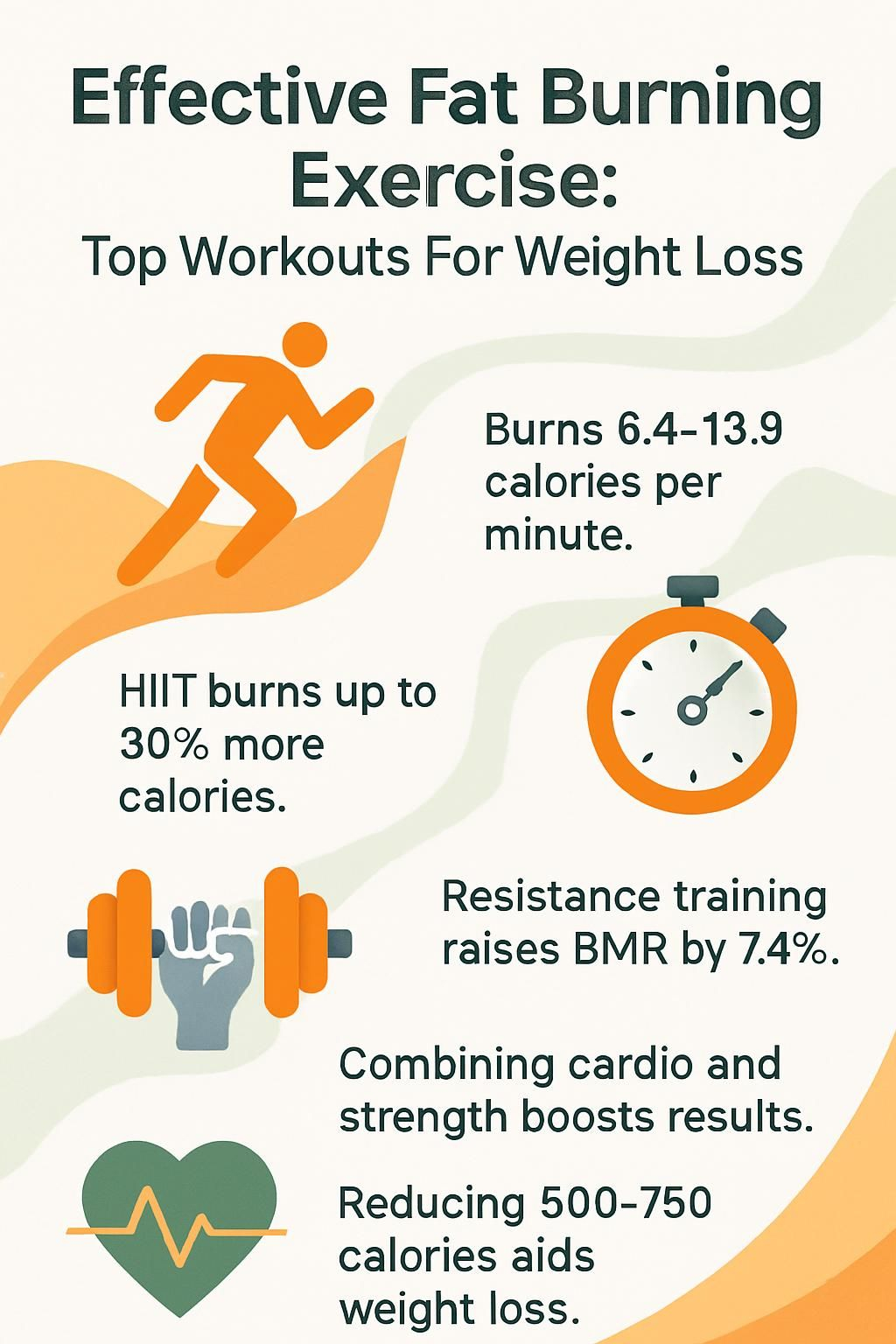Effective Fat Burning Exercise: Top Workouts For Weight Loss
Our Nutrition Assistant AI Suite will transform your body. You will lose fat, get toned, and build muscle. Gain confidence and optimal health.
Struggling to lose body fat even with regular exercise? The right fat-burning exercise raises your heart rate, helps you burn more calories, and supports steady weight loss.
With the best exercises for weight loss, you can reduce belly fat and lower the risk of type 2 diabetes and heart disease. You will also see how simple, time-smart workouts fit into a busy routine. Use this guide to choose workouts that help you reach a healthy weight faster.
Key Takeaways
- Cardio like walking, jogging, cycling, and swimming can burn roughly 6.4 to 13.9 calories per minute, depending on your weight and effort.
- High-intensity interval training, called HIIT, can burn up to 30% more calories per minute than steady exercise and increases post-workout fat burning through the afterburn effect, also called excess post-exercise oxygen consumption, or EPOC.
- Strength training, including squats, lunges, push-ups, deadlifts, and kettlebell swings, raises resting metabolism. A six-month study found resistance training increased basal metabolic rate by up to 7.4%.
- Combining cardio and strength training leads to greater fat loss and muscle gain, in line with Mayo Clinic and American College of Sports Medicine advice.
- Consistent workouts plus a balanced diet with a daily calorie reduction of 500 to 750 support long-term weight management, according to the 2020 to 2025 Dietary Guidelines.

Understanding Fat Burning and Weight Loss

Fat loss happens when your body uses stored energy. Knowing how exercise shifts your metabolism makes it easier to pick the best plan for weight loss.
What is the science behind fat burning?
Your body taps fat for energy when you move more or eat fewer calories. Stored fat lives in adipose tissue, which is simply your fat stores. During exercise, hormones such as adrenaline break down triglycerides, the main fat in your body, into fatty acids and glycerol. Your blood carries these to muscles for fuel.
As activity rises, calories burned go up. Over time, training adds muscle mass, which boosts your metabolism even at rest. More lean muscle means you burn more calories all day, even while sitting. Research from Mayo Clinic links lower body fat with reduced risk of heart disease, high blood pressure, diabetes, and some cancers.
Many people see faster progress after adding resistance training two or three times per week to a regular cardio routine. You keep lean muscle while losing weight, which improves body composition, or the mix of fat and muscle in your body.
How does exercise boost metabolism?
Exercise raises energy use while you move and after you stop. HIIT, which alternates hard efforts with easy recovery, can burn 25 to 30% more calories per minute than steady cycling, moderate running, or basic weight training. Short bursts spike heart rate, which leads to higher calorie burn.
Strength training increases basal metabolic rate, or BMR, the calories you burn at rest. In one trial, eleven minutes of resistance exercise three days a week raised resting metabolism by 7.4%. That translated to roughly 125 extra calories per day for some participants. In a 24-week study, men increased BMR by about 9%, and women by about 4%.
After tough workouts, your body uses extra oxygen to recover. This is EPOC, also called the afterburn. It keeps calorie burn higher for hours. Pair regular cardio with strength work to lift metabolism and shrink visceral fat, the deep belly fat tied to cardiovascular disease.
Effective Cardiovascular Workouts for Fat Loss
Cardio is like a thermostat for calorie burn, turn it up and your body uses more energy.
How does walking and jogging help with weight loss?
Walking and jogging are simple, joint-friendly ways to burn calories. A 140-pound person burns about 7.6 calories per minute while walking. At 180 pounds, it is about 9.7 calories per minute. Jogging between four and six miles per hour raises that to about 10.8 and 13.9 calories per minute for those same body weights.
Research shows that walking three times per week for 50 to 70 minutes can reduce body fat by about 1.5% in 12 weeks and trim inches from the waist. These activities help reduce visceral belly fat, which is linked to health risks.
“Walking every day helped me clear my mind and melted away stubborn abdominal fat,” shares Maria Lopez, a patient who worked with an exercise physiologist.
Start with 20 to 30 minutes, three or four days weekly. As fitness improves, you can add intervals or progress to cycling for a higher burn.
Can cycling help me burn fat?
Cycling is a strong calorie burner and is gentle on knees and hips. At 10 miles per hour, a 140-pound person may burn about 6.4 calories per minute. At 180 pounds, the burn can reach 8.2 calories per minute. Even a leisurely pace under 10 miles per hour can burn around 292 calories per hour for a 160-pound rider.
Regular biking can improve insulin sensitivity and lower risks for heart disease and some cancers. Many people stick with cycling because it is comfortable and easy to scale up or down by adjusting speed and resistance.
Why is swimming a good fat-burning exercise?
Swimming works your whole body without pounding your joints. At a moderate pace, a 140-pound swimmer may burn about 9 calories per minute. At 180 pounds, that can reach about 11.6. A 160-pound person can burn around 423 calories per hour with easy to moderate laps.
A 12-week trial with three 60-minute sessions weekly showed reduced body fat and better heart health. Breaststroke tends to burn the most calories, followed by butterfly, backstroke, and freestyle. If joint pain limits you on land, the pool lets you train longer with less stress.
Swimming can also reduce liver fat and improve overall body composition. It fits a wide range of fitness levels, including kids and adults who want preventive health benefits.
How does rowing provide a full-body workout?
Rowing trains both upper and lower body in each stroke. Your legs drive first, then your back and arms pull while your core stabilizes. This coordinated motion activates most major muscle groups at once.
Because it blends strength and cardio, calorie burn is high. A 155-pound person can burn roughly 260 calories in 30 minutes at a moderate pace, based on peer reviewed research from 2022. Rowing is also low impact and easy to adjust for beginners or advanced athletes. Use intervals for fat loss or steady rows for endurance.
How can dancing improve fitness and burn fat?
Dancing lifts your heart rate quickly and improves cardiovascular health. Aerobic dance classes can burn about 219 calories per hour for a 160-pound person, depending on style and intensity. You can stream classes at home or join a group class in a gym.
Dancing trains coordination, balance, and posture. It also works several muscle groups, which builds stamina over time. Aim for at least 150 minutes of moderate to vigorous dance each week to support fat loss.
Strength Training Exercises to Increase Fat Burning
Strength work turns your body into a 24-hour calorie burner, even on rest days.
How do squats and lunges strengthen the lower body?
Squats and lunges target your quads, hamstrings, glutes, and calves. As you lower and rise, these muscles control your body weight and build strength. More lean muscle increases daily calorie burn because muscle uses more energy than fat at rest.
Do squats and lunges at least twice a week. Use dumbbells or a weighted vest to raise intensity. A common plan is 1 to 3 sets of 12 to 15 reps. Sumo squats shift focus to the inner thighs and glutes. Strong legs support walking, cycling, swimming, dancing, and jump-rope work.
What push-up and pull-up techniques boost upper body strength?
For push-ups, hold a strong plank position. Keep your hands under your shoulders and your back flat. Try sets of 10 reps. A wide grip hits the chest more, and a narrow grip targets the triceps.
For pull-ups, switch between overhand and underhand grips to train your upper back and biceps. Include at least 5 to 10 reps per round, using assistance bands if needed. Clean reps with minimal swinging build strength faster and lower injury risk.
How do deadlifts and bench presses build core strength?
Deadlifts and bench presses train many muscles at once. They demand a braced core for balance and safety, which strengthens your midsection while you work the back, hips, chest, and arms. Federal activity guidelines recommend total body strength work for fat loss and muscle growth.
Use loads that tire your muscles in 12 to 15 reps. Keep your form strict and your core engaged. Compound lifts like these improve posture and functional strength, which carry over to daily tasks.
Why are kettlebell swings effective for full-body engagement?
Kettlebell swings train your hips, glutes, hamstrings, quads, core, shoulders, and grip. The explosive hip drive lifts the bell, which keeps your heart rate high. You get cardio and strength benefits at the same time.
In intense sessions, swings can burn up to 20 calories per minute. Choose a weight you can control. Hinge at the hips, avoid rounding your back, and keep the bell close to your body. Add swings to intervals for a powerful fat-burning circuit.
High-Intensity Interval Training (HIIT) and Fat Loss
Think of HIIT as the express lane for calorie burn, short efforts hit hard and pay off.
What is HIIT and how does it work?
HIIT means High-Intensity Interval Training. You perform very hard efforts, such as a 30-second sprint or fast bodyweight drills, followed by 1 to 2 minutes of easy movement. Sessions often last 10 to 30 minutes and can include running, cycling, or bodyweight circuits. This pattern raises heart rate fast and increases calorie burn.
You can scale HIIT to your fitness level by adjusting work time, recovery time, or movement choice. Studies show HIIT also supports lower cholesterol and better blood sugar control, which helps with weight management.
Source: American College of Sports Medicine, 2022.
What are the benefits of HIIT for fat loss?
HIIT can burn 25 to 30% more calories per minute than many steady workouts. After each session, EPOC keeps metabolism elevated for hours, so you continue to burn calories as you recover. Short sessions are easy to fit into a busy week.
HIIT often reduces belly fat and improves conditioning. It can also boost insulin sensitivity. Use controlled breathing and focus during hard intervals to manage stress and keep form sharp.
What does a sample HIIT workout look like?
- Do 30 seconds of sprinting at maximum effort, then 30 seconds of rest. This work and rest pattern sets up the session.
- Complete 30 seconds of burpees, then 30 seconds of rest. Burpees train the chest, legs, and core.
- Hold 30 seconds of plank jacks, then rest 30 seconds. Keep your hips level as your feet jump in and out.
- Jump rope for 30 seconds at a fast pace, then rest 60 seconds. Walk in place if you need extra recovery.
- Repeat the circuit up to 10 rounds, or stop when the total time reaches 15 to 30 minutes.
- If you are new to HIIT, start with 1 to 3 rounds. Add rounds as fitness improves.
- Keep form clean on every rep. Quality movement reduces injury risk and improves results.
- Schedule HIIT 2 to 3 days per week within a balanced plan that also includes strength work and lighter cardio.
Mixing sprints with jump rope is a simple way to raise intensity and cut workout time while still making progress.
Additional Exercises to Maximize Fat Burning
Short, focused moves can spike your heart rate and train several muscles at once.
How does jumping rope burn calories effectively?
Jumping rope is a fast, portable cardio workout. It uses your calves, quads, glutes, shoulders, and core at the same time. Many people burn 10 to 16 calories per minute, depending on body weight and speed. That level of effort boosts your heart rate and can raise metabolism after the workout.
Add jump rope to intervals for quick fat loss sessions. It also sharpens coordination, timing, and rhythm, which helps other exercises feel smoother.
What are skater jumps and how do they improve agility?
Skater jumps move you side to side like a speed skater. Leap laterally from one foot to the other and swing your arms for balance. This builds agility, coordination, and hip stability, and it also raises heart rate.
Use 30-second bouts between strength sets to keep intensity up. Training lateral movement helps prevent overuse injuries and improves performance in sports and daily life.
Why are sumo squats good for thighs and glutes?
Sumo squats use a wide stance to activate your inner thighs more than a standard squat. They also demand strong glute engagement, especially at the bottom of the movement. Add a dumbbell or kettlebell to increase the challenge.
Include sumo squats in a lower body day to build strength, shape the legs, and raise calorie burn. Teens and adults benefit from the stability this move builds.
How do burpees contribute to intense fat burning?
Burpees combine a squat, plank, push-up, and jump in one rep. This full-body pattern drives heart rate up quickly and uses many muscles at once. Sets of 10 to 15 reps can trigger a strong afterburn.
If burpees feel too hard, start with squat thrusts, that is, skip the push-up and jump. Progress slowly to protect your shoulders and lower back.
How do plank jacks strengthen the core?
Plank jacks ask you to brace your core while your feet jump apart and together. The constant motion challenges your abs and lower back more than a static plank. It also increases calorie burn because the move is dynamic.
Add 20 to 40 seconds of plank jacks to circuits for a stronger midsection and better stability in other lifts.
Combining Cardio and Strength Training Workouts
Blending methods gives you the best of both worlds, calorie burn now and a faster metabolism later.
What are the benefits of mixing cardio and strength exercises?
Cardio sessions raise your heart rate into target zones, often 60% to 90% of max, which burns many calories. Strength training builds muscle mass, which increases your resting metabolism. Together, they improve body composition and help prevent weight regain.
This mix also reduces boredom and lowers injury risk from doing the same thing every day. It is a practical approach for both weight loss and long-term weight management.
What does a weekly hybrid workout plan include?
- Complete 30 minutes of moderate aerobic exercise, like brisk walking or easy jogging, at least five days a week for a total of 150 minutes.
- Rotate cardio modes. Try swimming, cycling, rowing, or dance classes to challenge different muscles.
- Strength train two nonconsecutive days each week. Target all major muscles with 1 to 3 sets of 12 to 15 reps using enough resistance to tire the muscles.
- Use a simple circuit twice weekly: 10 squats, 10 lunges, 10 push-ups, 10 pull-ups, and 10 burpees.
- Add at least one HIIT session weekly with fast efforts like sprints or jump rope, plus short recovery periods.
- Schedule active recovery days with light stretching or easy cycling to support healing and consistency.
- Track your sessions with a watch or app to monitor time, heart rate zones, and progress.
Switching cardio modes across the week helps you break plateaus and keeps training interesting.
Tips to Enhance Fat Burning Results
Small, steady habits turn good workouts into lasting results.
Why is consistency important for fat loss?
Regular training is the strongest predictor of progress. Aim for at least 30 minutes of moderate cardio on most days, plus two or three focused fat-burning sessions each week. Skipping workouts makes results slower and motivation harder to maintain.
Pair consistent exercise with balanced meals. Plan workouts and meals on your calendar. Small steps, done often, lead to steady fat loss.
How can proper form and technique improve workouts?
Good form protects joints and ensures the right muscles do the work. Move with control, even during hard intervals. For example, in a squat, keep knees tracking over the middle toes and your chest lifted. That activates your glutes and protects your knees.
Research in the Journal of Strength and Conditioning Research shows athletes who focus on form have fewer injuries and better gains. Choose quality over speed for safer, stronger results.
Why are recovery days crucial for progress?
Muscles grow and repair during rest. Without recovery, fatigue builds and injuries become more likely. Evidence from the American College of Sports Medicine shows planned rest supports muscle growth and motivation during weight loss plans.
Take at least one full day off each week. Use light movement and sleep well so you come back stronger for the next workout.
How do hydration and a balanced diet support performance?
Water supports blood flow, temperature control, and muscle function. Even mild dehydration can cause cramps, fatigue, and slower reaction time. Drink before, during, and after workouts.
Build meals around lean protein, whole grains, fruits, vegetables, and healthy fats. If weight loss is your goal, reduce daily intake by 500 to 750 calories while staying active. Calorie needs often decline with age, so adjust portions over time. These steps fuel performance and help you lose weight in a sustainable way.
Common Workout Mistakes to Avoid
Avoiding common missteps can save time, soreness, and frustration.
What are the risks of overtraining?
Overtraining is too much stress with too little rest. It raises injury risk and can cause fatigue, poor sleep, irritability, and plateaus. Rapid weight loss from extreme exercise can increase the chance of muscle loss, dehydration, gallstones, and burnout.
Plan rest days and watch for warning signs like persistent soreness, lower performance, or mood changes. Scale back if these show up and focus on recovery.
Why should I never skip warm-ups and cool-downs?
Starting hard without a warm-up increases the risk of muscle strains and joint pain. A 2012 study in the Journal of Strength and Conditioning Research found athletes who warmed up at least 10 minutes had fewer soft tissue injuries.
Cool-downs gradually lower your heart rate and reduce next-day soreness. A short walk and light stretching are enough for most sessions.
What happens if I focus only on one type of exercise?
Doing only cardio can limit strength and slow your metabolism over time. Doing only strength work can leave your heart and lungs undertrained. Studies show that combining both leads to better fat loss and body composition than either alone.
Mix methods to keep progress steady and reduce overuse injuries. Variety also keeps training enjoyable.
How to Track Your Fitness Progress
Clear data keeps you honest and motivated through the ups and downs.
How can I track calories burned during workouts?
Apps and wearables estimate calorie burn from your heart rate, weight, age, sex, and activity. For example, a 160-pound person may burn about 606 calories per hour running at 5 miles per hour, or around 438 calories per hour while hiking. If you do not have a device, time your sessions and use simple charts for estimates.
During strength training, track sets, reps, weight used, and total time. Comparing days helps you plan harder or easier sessions for better results.
What are the best fitness apps and wearables to use?
Popular apps include MyFitnessPal, Strava, and Nike Training Club. Wearables like Fitbit Charge 5, Apple Watch Series 9, and Garmin Forerunner track heart rate and daily activity. Many devices sync with food logs to show how intake matches output.
Using an app and a wearable together can reveal helpful patterns, such as which workouts lead to better sleep or higher step counts the next day.
How do I set realistic fitness goals?
Safe weight loss is usually 1 to 2 pounds per week, about 1% of body weight. Make goals specific and measurable. For example, aim to walk 30 minutes five days a week, or complete 10 push-ups per session for two weeks.
Track progress weekly. Adjust your plan if a goal feels too easy or too hard. Celebrate small wins to build momentum and confidence.
Conclusion
Choosing the right exercise for weight loss makes progress faster and more sustainable. Blend cardio, strength training, and HIIT to burn calories now and raise your metabolism for the long term. Pair consistent workouts with a balanced diet, then track your effort so you stay motivated.
If you have a health condition or are new to exercise, talk with a healthcare professional before starting a new program. With steady habits and smart choices, you can reduce belly fat, improve fitness, and support lasting weight management.
FAQs
1. What are the most effective fat burning exercises for weight loss?
Research shows that aerobic activities like running, brisk walking, and cycling help burn calories quickly. Strength training also boosts metabolism by building muscle tissue. High-intensity interval training (HIIT) combines short bursts of intense activity with rest periods; studies report HIIT can increase fat loss more than steady-state cardio.
2. How often should I do these workouts to see results?
Experts recommend at least 150 minutes per week of moderate aerobic exercise or 75 minutes of vigorous activity for adults aiming to lose weight. Adding two days a week of strength training supports muscle growth and further calorie burn.
3. Can combining different types of exercise improve fat loss?
Mixing endurance activities with resistance routines leads to greater overall energy use and helps preserve lean body mass during weight reduction efforts. For example, alternating between swimming sessions and circuit workouts keeps your routine varied while targeting multiple fitness goals.
4. Do diet changes matter as much as exercise in losing body fat?
Studies confirm that pairing regular physical activity with balanced nutrition produces better outcomes than either approach alone. Tracking food intake alongside workout progress increases awareness and supports lasting lifestyle change.
Summary: Aerobic movement, resistance work, and interval sessions all contribute to effective fat burning when performed regularly each week. Combining these methods with mindful eating habits creates the best path toward sustainable weight management based on current scientific evidence and personal experience from those who have achieved their goals through consistent effort over time.







